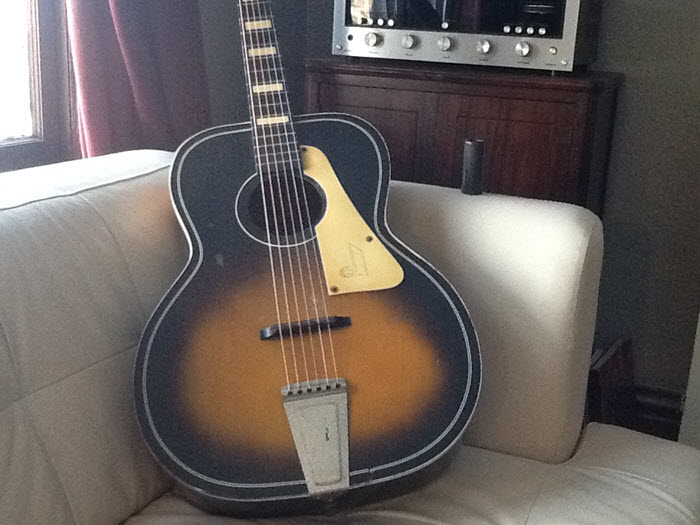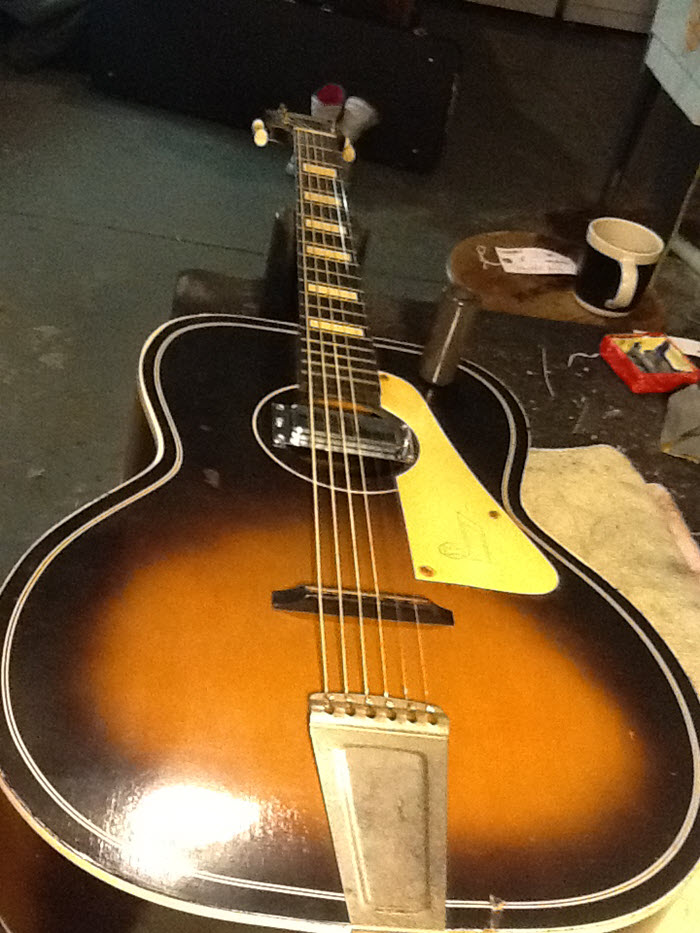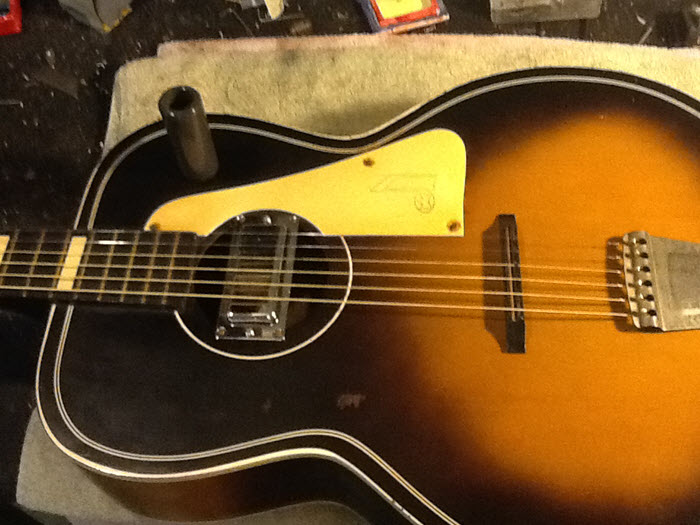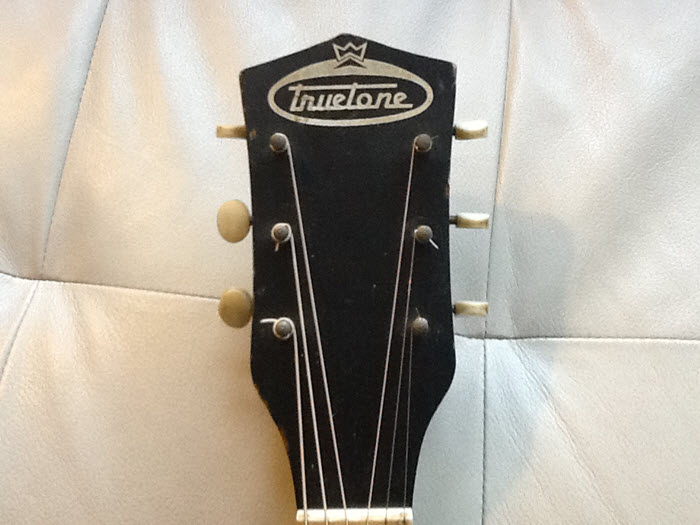
by Dave Anderson
So I have been getting into slide guitar quite a bit lately and have been diving into my blues collection for inspiration. One thing I noticed was the tone that guys like Elmore James and Lightning Hopkins were getting was not your typical electric guitar plugged into an amp an cranked. After a bit of research I realized that these guys were taking flat top acoustic guitars and mounting electric pickups on them to get their tone. So I set out to make a slide guitar that would pay homage to those blues artists of the past.
First, I set out to find the right guitar. Now I have a love for old, Chicago made Silvertone, Kay, and Harmony guitars. Due to the lack of truss rods, inconsistent neck sets, and non adjustable bridges, they can be a crap shoot as far as playability. But the tone of these budget acoustics is perfect for blues guitar in my humble opinion, and for slide playing, who can’t get along with a bit higher action? A quick search on the net and I found my specimen. A ’50s TrueTone acoustic that had a broken tuning key on Ebay for $100.00. I quickly pushed the buy now button and waited for my new
/ old guitar to arrive!
After a few days the UPS driver stopped on my street with a large, guitar shaped box! I quickly opened it up and found a decent looking TrueTone acoustic just as the seller described. I quickly ran to the bench with my new prize and went to work!
The guitar seemed to be in pretty good shape and the neck joint seemed stable and in tact. The action was a bit high as I expected but to my surprise, the neck was straight, Yes! I took off the old strings, and began to shave down the wooden, floating bridge. (quick tip: sometimes a floating wood bridge wants to move around a bit when bending strings, especially if it has been thinned down to lower the action. I like to use a bit of violin rosin on the bottom to help keep it in place!)After taking apart a few old tuner sets I had lying around, I found a gear that fit and repaired the broken tuning key. Did a light fret level and dress, and threw a set of light gauge strings on it for a test run!
My new blues machine was half way there, and played surprisingly well! With a big, canny, mid range voice, the old TrueTone proved itself up to the task for some delta slide. I then went through my pickup bin and found exactly what I needed. A cheap GFS firebird pickup that fit perfectly in the sound hole. I quickly wired it up to an end pin jack and mounted it in the guitar. I normally wouldn’t screw a pickup into the top of an acoustic guitar, but I was driven to get that Elmore James sound! Plus, for $100.00, why not…
I decided to restring it with medium gauge strings, tuned it to open D and let’er rip! The result was exactly what I wanted. Big, hollow, gritty blues with an open airy quality! If you have a desire to get into some slide guitar and are looking through your collection to see which axe is going to get revamped for heavy strings and higher action, you may look around a bit and find yourself a nice, vintage US made budget acoustic that you can turn into a blues machine! Of course you could always just get another Eastwood/Airline guitar and dedicate it to your slide explorations! I find my 2P Deluxe works great!
Written by Dave Anderson




Nicely done. Excellent choice. Great advice. People tend to forget that these old blues guys played what they had and made it work. That’s part of the mojo.
Nice article, good advice!
A friend recently brought me a “Chris Adjustomatic” 3/4 size guitar he had bought at a garage sale to set up for playing. These guitars were made in Columbus, OH, by the Jackson-Guldan company, and sold at Mongomery Wards stores. I am guessing that this particular model probably retailed for $15 – $20. It has a floating bridge, with a stamped steel tailpiece.
I did a major cleaning and setup, replaced the tuner bushings (which were missing), placed the bridge in the proper place, and strung it with medium gauge strings. 3/4 scale guitars are notoriously hard to tune, but once it was in tune, it had a wonderful, clanky, bluesy tone. I put it in Dropped D and it sounded just like Steve Winwood’s guitar on Can’t Find My Way Home.
I credit three things for this guitar’s marvelous tone. One, and I think the main reason, is the maple neck (with poplar fingerboard). This neck is heavy and solid, built like a miniature baseball bat. Then there is the steel tailpiece, that seems to lend it that wonderful metallic tone. Finally, the body is built heavy and solid as well, and was intact as far as not having any loose or cracked braces. The guitar weighs far more than similar 3/4-size ones. It’s unbelievable loud as well.
So my friend got a really great sounding, American-made guitar for a couple of dollars. I put a couple of hours work into it, and now it’s worth….$20??? Anyway, if one was looking for a guitar for the project you wrote about here, I would definitely recommend one from the Jackson-Guldan company. I had never seen one before – the company went under in 1971 – but I will surely be on the lookout for the next one.
Mice job and great sound! What amp are you playing through and did you use any pedals? The sound was great as was your playing.
Man that is one sweet sounding guitar,
great job. it inspire me to try something similar.
( wish i could play as well) thanks for sharing.
Great article and video! I have been playing slide as long as I’ve played guitar, nowadays I play slide 99% of the time. While I love old funky guitars like the Truetone you modded but they present problems for me. I tend to play 2-3 note chords and I have become very sensitive to intonation issues. I developed a jig to help me set intonation for slide by having a moveable bar that I can set at various points above the frets. this allows me to adjust the intonation for the areas I play most. I find that unless I am just playing single notes that I am uncomfortable without the ability to have precise intonation. I was lucky enough to get a Wechter acoustic that I added a sound hole magnetic pickup, the Wechter has excellent intonation. But beyond that I play electrics that I can set up for intonation. IMHO I developed a very critical ear from slide and this served me well with fretless instruments, I play electric cello, fretless guitar and fretless bass now as well. But slide guitar will always be my first love, fretted instruments just seem very limiting to me anymore.
What is it with Truetone and slide?
I have an old Truetone Vanguard that I use exclusively for slide. The only guitar I’ve ever owned where the middle selector position is my ‘go to’. (I’d post a pic if I could figure how to.)
Sounds totally the biz.
Now if you could just mount a Truetone pick up in an old acoustic …
I use a very similar Silvertone for slide. What strings did you use?
Awesome – medium electric or acoustic strings?
Great article! I’ve got an old Truetone flat-top with the funky fenderish headstock they used one year. I was going to dump it but will now slide-a-fy it. Keep up the excellent writing…………..
Thanks for the great compliments eveyone! David, I used a Bearfoot FX Honeybee and a TC Electronics Flashback through a Goodsell Valpreaux 21 amp. Richard Goodsell is out of Atlanta, and makes killer hand wired amps at a very resonable price!
That sounds fantastic. I play lefty and probably am not going to find something like this in a lefty. If I found an old guitar like this and wanted to convert it, do you think it would just require a new nut or would I have to replace the bridge as well?
Hi Dave… great stuff, i was wondering if we have a mutual friend by the name Jon Margolis, and if so… it’s been a long time. Cheers from Deadwood!
wow! Maybe houndog was just thrifty! You are getting some great mojo there, I think its a combo…the instrument & the player will reveal what they each have to offer eventually. I’m an old bluesman i hope you understand
I have a Telleno flattop parlour from the 40’s (?) anyway it is the ultimate guitar for the godly tone that Elmore produced. Elmore is my idol, so I’m pretty happy about my discovery. I’m 13 by the way.
I was given that exact guitar as a kid in ’79. I always thought it was made in the 70s. If it would not be too much of a pain could you tell me the code stamped on the inside? Mine needs a new bridge so I may also bother you for some dimensions and some close up pics.
Thanks in advance,
Tim
Hi there !
I too am obsessed with Elmore James’ music.
I have been trying for nearly 30yrs or so to play like him and get his guitar sound.
I experimented with an old Takemine dreadnought acoustic I had – the ones often referred to as the Martin lawsuit one – as the headstock shape and Takemine decal was very much made to look like a Martin guitar.
I tried all sorts of pickups on this guitar. I had an aftermarket soundhole pickup by Schaller which sounded fairly good – but I don’t think I ever tried it with anything other than acoustic phosphor-bronze strings – as it didn’t occur to me to try electric guitar strings :
http://www.amazon.co.uk/Schaller-10-43-Vintage-Soundhole/dp/B00BJPY0JC/ref=sr_1_61?ie=UTF8&qid=1415884484&sr=8-61&keywords=guitar+pickups+for+acoustic
Then I got some nice Seymour Duncan pickups and installed them in the soundhole – a Dogear P90 Antiquity Special, and a Fender Strat type pickup – both at the same time, with switches to have either pickup or both on – with the option for being wired in-series and in-parallel.
The P90 overpowered the Strat pickup though. Sounded great BUT was too grungy on the 5th and 6th strings – suing electric guitar strings.
Finally, with the advent of me having internet access in about the year 2000, and soon after finding EBAY, I was able to start searching to find a match to what Elmore had on his guitar. Finally I found what pickups he had on his Kay acoustic. These often sell for big bucks – so it took me a while to get some at decent prices. Eventually I also sourced a Kay dreadnought – EXACTLY the same model as Elmore’s – and mount the pickups to it. The guitar did need a lot of restoration work. It’s a very rare model. I searched EVERY day on ebay for 7 yrs before one came up – and I got it ! Another appeared 3yrs later, and a friend in the US got that one. 3yrs later, another one just turned up on ebay – and I won that one. Other than those 3 guitars, and Elmore’s one, I’ve never seen any others in about 16yrs of searching the internet. Rare !!!
Anyway, here are a couple of videos of me playing my Kay acoustic with the pickup I am 100% certain Elmore used on his recordings – as it has the sound (tone, sustain and “break-up” like on his recordings).
https://www.youtube.com/watch?v=ZlrDBiu2VU0
https://www.youtube.com/watch?v=n5clkRMRPug&list=UUXXXwW1nUxs6EjMpsIX06VQ
I think the bass strings sound was a bit weak with this pickup and at high volume amp settings (in old non-master-volume valve amps), the sound gets too fizzy and thin when turning up the amp beyond about half-way. Thus, I imagine Elmore experimented with other soundhole pickups for live gigs, trying to find a pickup that worked well at higher amp volumes, as can be seen in various soundhole pickups in pictures of Elmore with his Kay acoustic.
However, I believe Elmore stuck with his main pickup for all his recordings. It’s a Dearmond Rhythm Chief Model 1000 pickup, first produced in 1948 – and intended for archtop F-hole acoustics.
Elmore sticks his onto his Kay acoustic guitar-top, between the soundhole and the bridge (ie. not in the soundhole) – and the control box (Volume, Tone and “Rhythm Switch”) is screwed down onto, and hangs down from the treble side of the bridge. In all but one picture of Elmore with his Kay guitar, you can’t see the pickup, as his right hand is over the pickup – but you can see the control box hanging down from the bridge.
In the only colour photos of Elmore, from an October 1959 gig, Elmore has a Dearmond RHB-C soundhole pickup on his guitar (as well as the Rhythm Chief pickup). it looks like a Fender Strat pickup set in a chrome surround, curiously with the 2nd string polepiece “missing”. Most people assume that this soundhole pickup is the one to use to get Elmore’s sound – as that is really the only pickup you can see – AND those colour photos are the most well known photos of him. Two plus two equals five, so it seems !!!
This Dearmond soundhole pickup is not on his guitar on any other photos other than that October 1959 date. It’s not even on his guitar 2 months later, in December 1959 gig photos. I don’t think Elmore was impressed with this pickup. I have one – and it just doesn’t have that Elmore sound – the tone, sustain and “break-up” when you hit the strings hard.
If you don’t believe me, check out this YouTube video, where I compare both pickups, on another Kay acoustic I used to have (a later, poorer quality Kay dreadnought) :
https://www.youtube.com/watch?v=J_gCjZ5ZoUI
All the best !